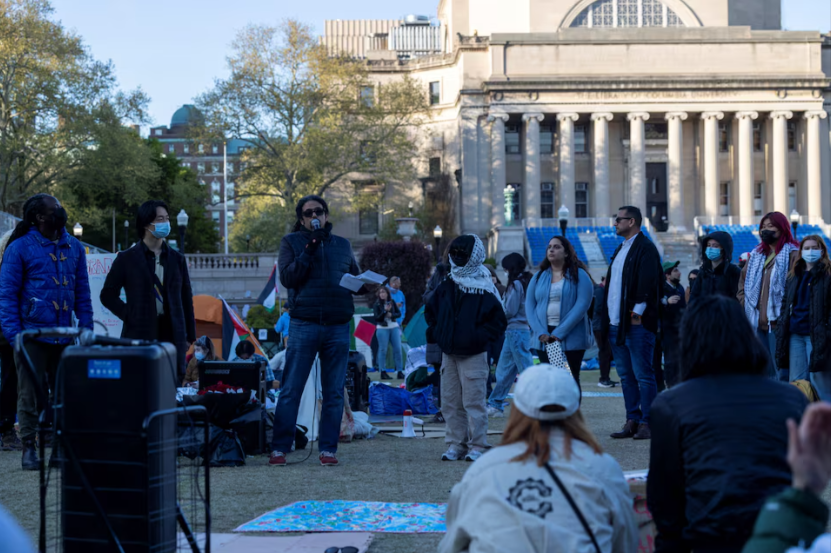
Before students set up a pro-Palestinian protest encampment on a Columbia University lawn last week, some of them took an optional course called “Columbia 1968” about protests against the Vietnam War, a similarly galvanizing moment of campus activism.
Frank Guridy, the Columbia history professor who has taught the class since 2017, along with a couple of his students stopped by the encampment at the New York City campus on Thursday to discuss the parallels at a teach-in called “1968: Continuing the Fight.” Protesters listened sitting on mats on the grass outside their tents, eating free kidney beans and rice and kosher Passover snacks off paper plates from a nearby community kitchen set up on tables under canopies.
The school administration suspended dozens of protesting students and had them arrested last week. Some of them say they are only acting on the lessons and education they have received on campus as they oppose Israel’s war in Gaza.
Bo Tang, a second-year undergraduate history student, said he was part of the student protesters’ research group, which looked at the strategies and tactics of past and present social justice movements to “try to take lessons from them.”
The group interviewed alumni involved in the 1968 protests, some found through Guridy’s class, Tang said, getting them to share lessons on building support for a protest movement.
Tang and other students say classmates and professors previously agnostic about the protest showed up at the encampment after police were called in, including faculty who have donned yellow vests to help with security and safety.
Protest encampments have also appeared at colleges across the U.S. and abroad in solidarity with the Columbia students, drawing criticism from the White House, many Republican lawmakers and Israeli Prime Minister Benjamin Netanyahu, who call the protesters antisemitic and intimidating to Jewish students.
Many Jewish students are among the organizers, though, and bristle at allegations of antisemitism. Over many hours spent at the encampment this week, Reuters journalists have seen students peacefully chatting, reading, eating and holding both Jewish and Muslim prayer ceremonies. There have been jazz performances, lectures, first aid courses, bouts of pro-Palestinian revolutionary chants and writing workshops. Sometimes heated but non-violent debates break out between anti-Zionist Jews and pro-Israel students visiting the camp.
A typical sign warns those in the encampment, however, to be careful in their interactions with counterprotesters: “WE DO NOT ENGAGE WITH INSTIGATORS.”
‘LIBERATED ZONE’

The student protesters set up the encampment at dawn on April 17 without required school permission, demanding Columbia divest from weapons manufacturers and other companies that support Israel’s government and military. The protests, held in coalition with dozens of other student groups, have been led by Columbia chapters of Students for Justice in Palestine and Jewish Voice for Peace, both of which the school suspended in November for an earlier unauthorized pro-Palestinian protest.
The day after the encampment was set up, Columbia President Minouche Shafik called in police, who arrested 108 of the students on trespassing charges, outraging some faculty. Students have since rebuilt the encampment, more bustling than before.
Shafik, who declined interview requests through a spokesperson, has said she called police as a last resort for rule-breaking, that the encampment has caused “rancor” on campus, and that school policy cannot be dictated by a subset of students and staff. Her administration has been holding stop-and-start negotiations with the protesting students, while steadily filling adjoining lawns with bleachers and scaffolding ahead of the school’s May 15 commencement ceremony.
“We have our demands; they have theirs,” she wrote in a campus-wide email.
At his teach-in, Guridy and his students told the protesters how their 1968 predecessors were outraged by Columbia disciplining six students who had protested the school’s ties to weapons research, and the university’s plans to build a racially segregated gym near Harlem.
The 1968 protesters occupied multiple buildings on campus and held the acting dean hostage for a day before police violently ended the occupation a week later, arresting some 700 students.
The 2024 protesters decided to instead occupy one lawn of the main Columbia campus, noting that school administrators recently designated it for protests, albeit with permission.
Maryam Alwan, a third-year Palestinian-American undergraduate student among those arrested and suspended last week, said the easily circumvented hedge-lined lawn was chosen so administrators could not accuse them of disrupting classes.
“We looked at some of the imagery of the ’68 protests,” Alwan said. A famous photograph of the 1968 protests shows students holding a large sign saying: “Liberated Zone.” The 2024 protesters erected a similar sign over their camp, and Alwan was delighted to see the sign since spread to other campuses.
“My class is not a boot camp for revolution,” Guridy said in an interview after his teach-in. “It’s a history class.”
He called Tang one of his “sharpest students.”
Around protests, Tang still has to finish his final paper for Guridy’s “Columbia 1968” class.
“It’s hard to get A-pluses in the humanities classes,” Tang said. “But I’m shooting for it.”